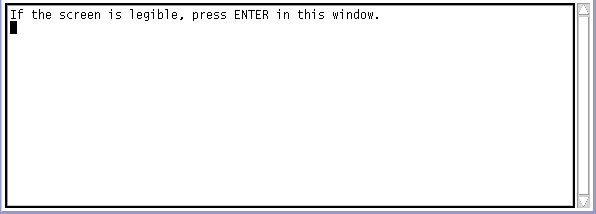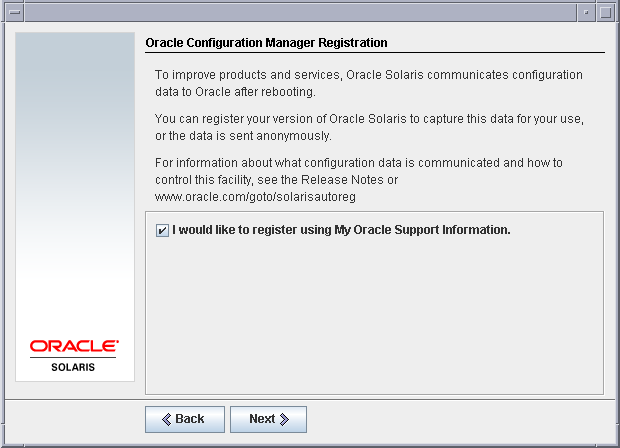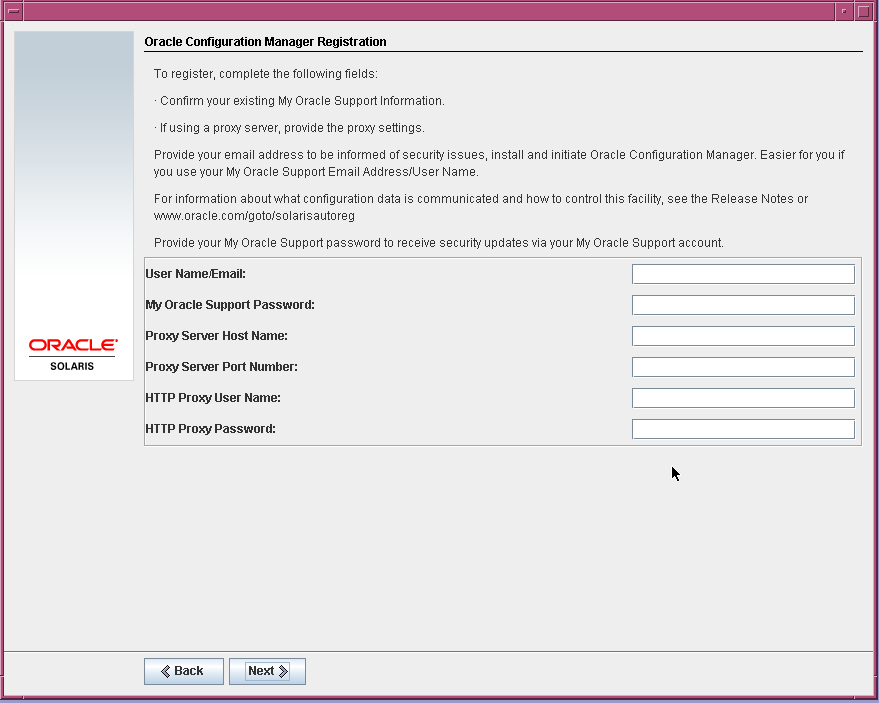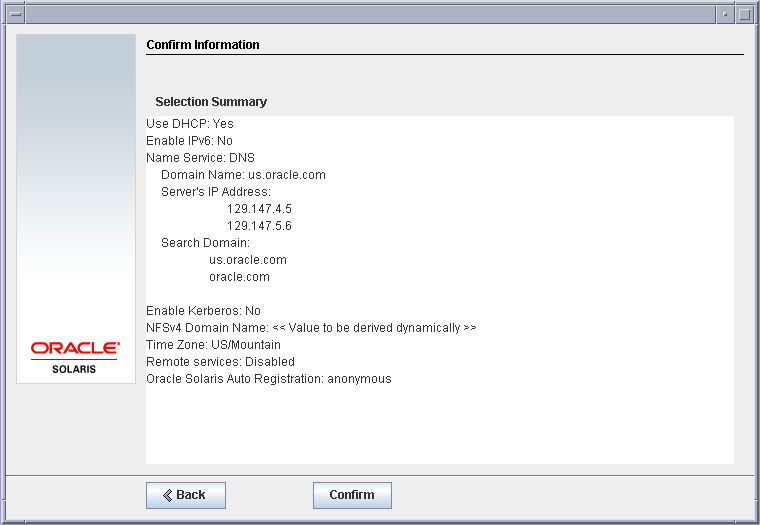| Skip Navigation Links | |
| Exit Print View | |

|
Oracle Solaris 10 1/13 Installation Guide: Basic Installations Oracle Solaris 10 1/13 Information Library |
| Skip Navigation Links | |
| Exit Print View | |

|
Oracle Solaris 10 1/13 Installation Guide: Basic Installations Oracle Solaris 10 1/13 Information Library |
1. Planning for a Oracle Solaris Installation From CD or DVD Media (Tasks)
2. Installing With the Oracle Solaris Installation Program For UFS File Systems (Tasks)
Pre-Installation or Upgrade Preparation
To Prepare for an Installation or Upgrade
x86: To Install or Upgrade With the Oracle Solaris Installation Program With GRUB
4. Installing the Oracle Solaris 10 OS on an iSCSI Target Disk
For UFS file systems, you can either install or upgrade the Oracle Solaris OS by using the Oracle Solaris installation program. This section lists the tasks you need to perform to install the Oracle Solaris OS, and provides detailed instructions about how to install the Oracle Solaris OS from DVD or CD media.
If you want to install the Oracle Solaris OS on a machine or domain that does not have a directly attached DVD-ROM or CD-ROM drive, you can use a DVD-ROM or CD-ROM drive that is attached to another machine. For detailed instructions, refer to Appendix B, Installing or Upgrading Remotely (Tasks), in Oracle Solaris 10 1/13 Installation Guide: Network-Based Installations.
Note - Starting with the Oracle Solaris 10 9/10 release, only a DVD is provided. Oracle Solaris Software CDs are no longer provided.
If you have a system that contains non-global zones, Live Upgrade, a feature of Oracle Solaris, is the recommended upgrade program or program to add patches. Other upgrade programs might require extensive upgrade time, because the time required to complete the upgrade increases linearly with the number of installed non-global zones.
For information about upgrading with Live Upgrade, a feature of Oracle Solaris, see Part I, Upgrading With Live Upgrade, in Oracle Solaris 10 1/13 Installation Guide: Live Upgrade and Upgrade Planning.
This procedure describes how to install a stand-alone SPARC based system from CD or DVD media for UFS file systems. For more information about how to prepare for an installation or upgrade, see To Prepare for an Installation or Upgrade.
The ok prompt is displayed.
ok boot cdrom
ok boot cdrom - text
Specifies to run the text installer in a desktop session. Use this option to override the default GUI installer.
ok boot cdrom - nowin
Specifies to run the text installer in a console session. Use this option to override the default GUI installer.
Note - Starting with the Oracle Solaris 10 1/13 release, the text installer enables you to select network based installation when installing Oracle Solaris from a CD/DVD. This enhancement provides an option to install Oracle Solaris from a CD/DVD or from the network file system.
For detailed information about the Oracle Solaris installation GUI and text installer, see Oracle Solaris Installation Program GUI or Text Installer Requirements.
If the operating system cannot locate a self-identifying keyboard, a screen displays keyboard layout selections.
Note - PS/2 keyboards are not self-identifying. You will be asked to select the keyboard layout during the installation.
The system configures the devices and interfaces and searches for configuration files.
If you selected a GUI installation in the earlier steps, the next two screens confirm GUI functioning.
Starting Oracle Solaris Interactive (graphical user interface) Installation +------------------------------------------------------------+ | You must respond to the first question within 30 seconds | | or the installer proceeds in a non-window environment | | (console mode). | | | | If the screen becomes blank or unreadable the installer | | proceeds in console mode. | | | | If the screen does not properly revert to console mode, | | restart the installation and make the following selection: | | | | Oracle Solaris Interactive Text (Console session) | -------------------------------------------------------------+
If your system has insufficient memory to display a graphical user interface (GUI), the program exits and displays an error message. You can address this issue in one of two ways:
Upgrade your system's memory and restart the installation.
Restart the installation and select the text installer option rather than the GUI installer option.

See Chapter 2, Preconfiguring System Configuration Information (Tasks), in Oracle Solaris 10 1/13 Installation Guide: Network-Based Installations for more information.
Use the Checklist for Installation to help you answer the configuration questions.
If desired, you can enable network services after installation by using the netservices open command or by enabling individual services by using SMF commands. See Revising Security Settings After Installation in Oracle Solaris 10 1/13 Installation Guide: Planning for Installation and Upgrade.
For further information about these options, see Planning Network Security in Oracle Solaris 10 1/13 Installation Guide: Planning for Installation and Upgrade.
The Installer Questions screen appears.
Important: If you intend to disable Auto Registration after installation, deselect the automatic reboot.
The Specify Media screen appears.
The License panel appears.
The Oracle Solaris installation program then determines if the system can be upgraded. To upgrade, the system must have an existing Oracle Solaris root (/) file system. The Oracle Solaris installation program detects the necessary conditions and then upgrades the system.
The Select Upgrade or Initial Install screen appears.
The next screen enables you to choose a default installation or a custom installation.
Install a specific software group
Install additional software
Install specific software packages
Install a specific locale
Customize the disk layout
For more information about software groups, see Disk Space Recommendations for Software Groups.
Note - The text installer does not prompt you to select a default or custom installation. To perform a default installation, accept the default values that are provided in the text installer. To perform a custom installation, edit the values in the text installer screens.
Note - If you intend to disable Auto Registration at the end of the installation or upgrade, you can proceed through these Auto Registration screens without providing any information.
The following figure shows the GUI version of the Auto Registration screen. The test installer version displays the same text. Click Next to continue.

In the text installer screen, use the arrow keys to navigate to the option box. Press Return to mark the option box to select registering with your support credentials. Press Esc-2 key to continue.
The following figure shows the GUI version of the Auto Registration data entry screen. The text installer version provides the same options.

If you chose to register with your support details, you are prompted to provide your My Oracle Support user name and password. If you use a proxy server, you can provide the server host name and port number, and the proxy user name and password.
If you chose to register anonymously, this screen asks only for the proxy information.
For the text installer version, use the arrow keys to navigate between lines. Type your support credentials and optional proxy entries. Press the Esc—2 key to continue.
The Ready to Install screen is displayed.
The following figure shows the GUI screen. The text install screen contains the same summary information.

When the installation program finishes installing the Oracle Solaris software, the system reboots automatically or prompts you to reboot manually.
If you are installing additional products, you are prompted to insert the DVD or CD for those products. For installation procedures, refer to the appropriate installation documentation.
After the installation is finished, installation logs are saved in a file. You can find the installation logs in the /var/sadm/system/logs and /var/sadm/install/logs directories.
# reboot
# rm /a/var/tmp/autoreg_config
# reboot
Note - After an installation, the Oracle Configuration Manager (OCM) is enabled by default. The OCM service can be disabled using the following command:
svcadm disable ocm